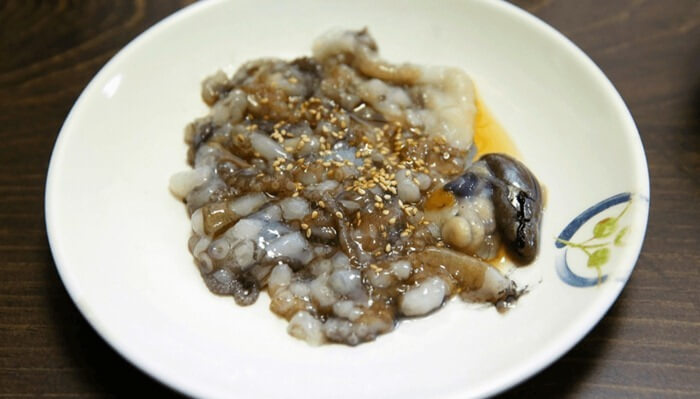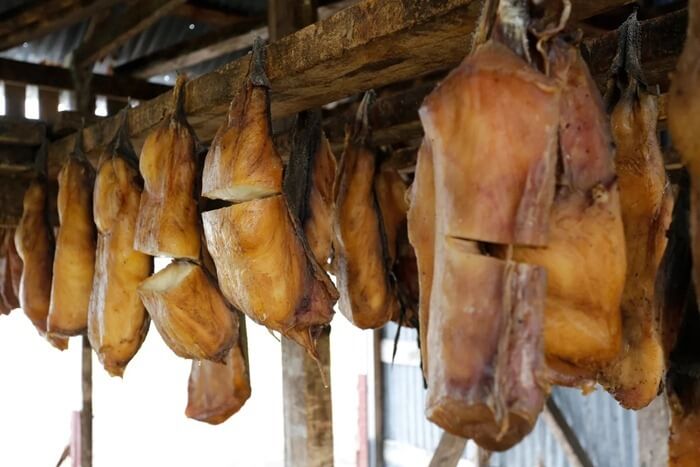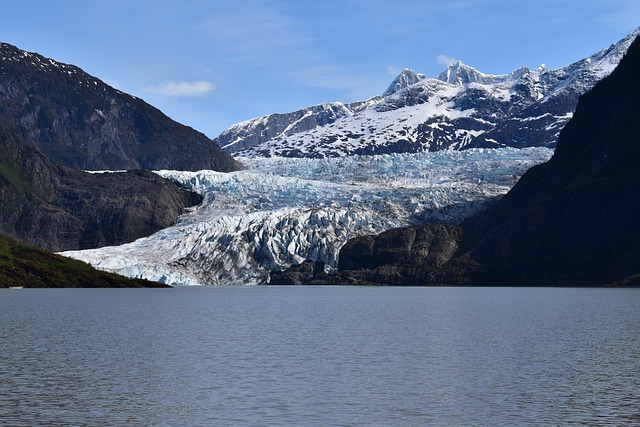There is a big difference between eating something that is tasty but not healthy and eating something that can kill you. And if you want to stay in good health as long as possible, exclude from your diet what is listed in our top 10 the most poisonous foods in the world.
10. Monkey brains

Remember the scene from Indiana Jones and the Temple of Doom where the heroes are served chilled monkey brains? As it turns out, this exotic dish can reward you with a deadly disease. Monkey brains can be a source of infection that leads to Creutzfeldt-Jakob disease. It is fatal in 85% cases, even if it occurs in a mild form. Here is a list of the main symptoms:
- epileptic seizures;
- depression and other mental disorders;
- blindness;
- loss of the ability to speak and understand language;
- difficulty swallowing;
- chronic pain.
There is no known cure or even way to slow the progression of Creutzfeldt-Jakob disease.
9. Rhubarb

This plant can be used to make a delicious pudding or pie, but if you eat the wrong part of the rhubarb, it could be your last meal.
Rhubarb leaves contain chemicals called oxalates. When ingested by humans, they can cause breathing difficulties, seizures, kidney failure, and even death. Rhubarb stems also contain oxalates, although in small amounts.
8. Sannakchi

This deadly gastronomic delicacy originates from Korea. Live octopus is cut into pieces, seasoned with sesame oil, sprinkled with sesame seeds and served. But even in this state, the octopus is still dangerous. Its suckers can stick to your throat and mouth, causing suffocation. There are known cases of people choking to death after eating sannakji.
7. Aki

This is the "national" fruit of Jamaica. When unripe, it is not one of the healthiest fruits, due to the hypoglycine content. This is a poison that causes what is called "Jamaican vomiting sickness". Once the fruit is ripe, it becomes safe. So if you are in Jamaica, eat the yellow ackee fruit, and never eat the seeds, they are always toxic.
6. Cashews

"What nonsense! I've eaten cashews a hundred times and nothing happened," the reader might exclaim. And he'll be right. Nothing happened because the toxic substances - anacardic acid (similar in action to poison ivy) and cardol - are not in the nut itself, but in the shell that surrounds it.
To make the product safe to eat, cashews are first removed from their shells, then softened in water, and then dried to remove the dangerous acid. But this must be done at a fairly high temperature of 125°, or traces of the poison may remain on the roasted nuts.
And “raw” cashews are a marketing ploy; all these tasty nuts are steamed before being sold.
5. Bloody clams

The fifth place in the list of deadly dangerous products is taken by food popular in Asian countries. These seafood products got their name due to the high content of hemoglobin. Because of it, it seems that the shellfish are bleeding.
Bloody clams can also carry blood diseases such as hepatitis A, typhoid fever, and dysentery. This is because they live in low-oxygen conditions where many viruses and bacteria thrive.
In 1988, a hepatitis A epidemic was recorded in Shanghai, caused by the consumption of bloody shellfish. More than 300,000 people were infected, and 30 people died, according to the Shanghai Daily.
4. Hakarl

This is the name of dried shark meat, one of the traditional dishes of Iceland. It is better not to try this food of ancient Vikings, because shark meat contains poisons such as trimethylamine oxide and uric acid.
Preparing the hakarl involves cutting up the shark and placing the pieces in gravel filled containers with holes in the sides. The pieces are left there for a couple of months to allow the poisons to drain out of the carcass along with the liquids. Then they are left to “ripen” in the open air for another 2 to 4 months. However, this does not always work and then the eater is left to suffer all the “delights” of severe poisoning.
3. Fisih

In Egypt, the Nile River has always been a source of life. But it was also the source of a springtime “harvest” of rotting fish when the floodwaters receded. Some clever person back in the time of the pharaohs put together the fish and the magic of the flood season. That’s how the holiday of Shem al-Nissim, which translates as “the smell of the breeze,” was born.
Nowadays, Egyptians also eat feseekh, a fermented fish dish. No one likes this dish, but tradition is tradition. To prepare feseekh, mullet is dried in the sun and placed in a vessel with salt water for a month and a half. Technically, salt prevents rotting, but the fish remains raw and stinks. However, the main problem is not this, but botulism. If there is not enough salt or the fish has already begun to rot, pathogenic bacteria begin their own holiday. Botulinum toxin is a nerve toxin that paralyzes muscles. The symptoms of botulism are similar to a stroke.
Botulinum toxin is also injected into people's faces in very low concentrations to make them look younger. This procedure is called "Botox".
2. Casu Marzu

This is the most unusual national dish of Sardinia and at the same time the most dangerous cheese in the world. It is made from ordinary pecorino cheese, bringing it to the stage of rotting. Cheese flies lay their eggs in the "rotten cheese" (as its name is translated), and larvae hatch from these eggs. Their task is to decompose the cheese, which becomes very soft. And then it is up to the people who dare to try casu marzu.
Whether you remove the maggots from your cheese before eating is a matter of taste. But it’s best to cover the cheese with your hand before biting into it: disturbed maggots can jump up to 15 centimeters. However, a maggot in your eye is not the worst thing that can happen. Some cheese fly maggots do not die once inside a person. They are such resilient creatures that even stomach acid does not always affect them. Once you digest the rotten cheese that the maggots once called home, they begin looking for a new place to live. And since they are inside you, guess what they will choose? It is certainly strange to have maggots in your throat, but it is definitely worse to have them crawling along the walls of your intestines.
1. Fugu

Name the most dangerous delicacy in the world translates as "river pig". But you won't get bacon from this pig, instead the fugu (one of the representatives of the numerous family of pufferfish) contains large amounts of tetrodotoxin. This powerful neurotoxin is used by the fish during life to protect itself from predators. And after death - as revenge on people who wanted to eat it.
Tetrodotoxin affects the human nervous system and inhibits the transmission of nerve impulses. First, there is a tingling sensation in the mouth, followed by dizziness, nausea, and headache. It becomes difficult to breathe. Then your muscles begin to tense up as you lose control of your entire body, eventually becoming completely paralyzed. You do not lose consciousness, so you know exactly what is happening until the moment when the neurotoxin causes your heart to stop and your lungs to stop functioning.
When prepared correctly by a trained, certified chef, fugu is safe to eat. But if there is a piece of flesh left over during cooking that contains tetrodotoxin, it will probably be your last meal. The liver, caviar, and milt are especially toxic. Improperly prepared fugu kills, according to various sources, between 30 and 50 people a year. That's why we put it at the top of the list of the most dangerous foods on Earth.














Оставить Комментарий